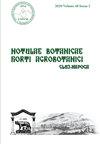诱导铬胁迫下玉米各种植物组织的蛋白质组变化
IF 1.3
4区 生物学
Q3 PLANT SCIENCES
引用次数: 0
摘要
重金属污染正在成为环境污染的主要原因,直接影响人类、动物和植物。由于铬(Cr)在制革工业中的广泛应用,铬被认为是一种高度危险的环境毒素。本研究旨在调查两种玉米品种(NMH-360 和 DKC 61-42)在铬(0、50 和 150 ppm Cr)胁迫下不同植物组织(叶片、嫩枝和种子)的生长和蛋白质变化。利用十二烷基聚丙烯酰胺钠凝胶电泳(SDS-PAGE)观察植物蛋白质组在铬胁迫下的变化。结果表明,在 150ppm 的条件下,两种玉米品种的植物生长特性都有所下降。此外,还发现植物蛋白质组在叶片和嫩枝组织中对铬胁迫的反应发生了变化。一些蛋白质被上调(C1 品种为 70 kDa),而另一些则被下调(C1 栽培品种嫩枝中为 154、140、115、80、70 和 53 kDa,而 C2 栽培品种嫩枝中为 154、65、60 和 17 kDa 条带)。有些蛋白质条带在 50 ppm 浓度下被诱导,有些在 150 ppm 浓度下被诱导,还有些在两种浓度下都被诱导。这项研究的结果有助于选择耐受铬的植物品种,也有助于设计新的蛋白质生物标志物,作为监测重金属胁迫反应的工具。本文章由计算机程序翻译,如有差异,请以英文原文为准。
Proteomic alterations in various plant tissues of maize under induced chromium stress
Heavy metal contamination is becoming a major cause of pollution in the environment, impacting humans, animals, and plants directly. Because of its widespread use in the tanning industry, chromium (Cr) regarded as a highly dangerous environmental toxin. The goal of this study was to investigate growth and proteins changes in different plant tissues (leaves, shoots, and seeds) of two maize cultivars (NMH-360 and DKC 61-42) under the stress of Cr (0, 50, and 150 ppm Cr). Sodium dodecyl polyacrylamide gel electrophoresis (SDS-PAGE) was used to observe plant proteome modification in response to Cr stress. Results revealed that at 150 ppm, both maize cultivars showed a decrease in plant growth attributes. Furthermore, it was noticed that the plant proteome changed in response to Cr stress in leaf and shoot tissues. A few proteins were up-regulated (70 kDa in C1 variety), while others were down-regulated (154, 140, 115, 80, 70 and 53 kDa in C1 cultivar shoots while 154, 65, 60, 17 kDa bands in shoots of C2 cultivar). Some protein bands were induced at 50 ppm, some at 150 ppm, and yet others at both concentrations. The findings of this study could aid in the selection of Cr-tolerant plant cultivars as well as the design of new protein biomarkers that can be utilized as a monitoring tool in heavy metal stress responses.
求助全文
通过发布文献求助,成功后即可免费获取论文全文。
去求助
来源期刊

Notulae Botanicae Horti Agrobotanici Cluj-napoca
PLANT SCIENCES-
CiteScore
2.70
自引率
0.00%
发文量
118
审稿时长
3 months
期刊介绍:
Notulae Botanicae Horti Agrobotanici Cluj-Napoca is a peer-reviewed biannual journal aimed at disseminating significant research and original papers, critical reviews and short reviews. The subjects refer on plant biodiversity, genetics and plant breeding, development of new methodologies that can be of interest to a wide audience of plant scientists in all areas of plant biology, agriculture, horticulture and forestry. The journal encourages authors to frame their research questions and discuss their results in terms of the major questions of plant sciences, thereby maximizing the impact and value of their research, and thus in favor of spreading their studies outcome. The papers must be of potential interest to a significant number of scientists and, if specific to a local situation, must be relevant to a wide body of knowledge in life sciences. Articles should make a significant contribution to the advancement of knowledge or toward a better understanding of existing biological and agricultural concepts. An international Editorial Board advises the journal. The total content of the journal may be used for educational, non-profit purposes without regard to copyright. The distribution of the material is encouraged with the condition that the authors and the source (Notulae Botanicae Horti Agrobotanici Cluj-Napoca or JCR abbrev. title Not Bot Horti Agrobo) are mentioned.
 求助内容:
求助内容: 应助结果提醒方式:
应助结果提醒方式:


